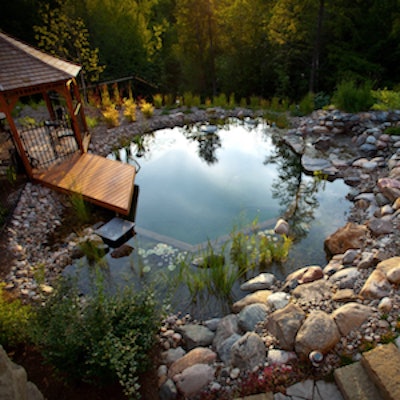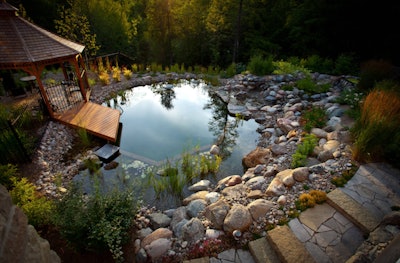
To be successful amid the outdoor living boom, it's critical for retailers and builders to stay abreast of rapidly changing consumer tastes in backyard products. To help keep your product lines up to date, AQUA has partnered with design megasite Houzz to bring you more content about outdoor living, from pools and spas to outdoor kitchens and patio furniture. Here, a Houzz expert dives into the world of natural swimming pools.
Natural swimming pools use plants or a combination of plants and sand filters to keep the water clean and clear without chemicals. They were developed in Austria and Germany in the 1980s and have since grown in popularity worldwide. They can be designed in a multitude of ways: Some look like natural ponds; others may be disguised as standard tiled pools.
Whatever look you are trying to achieve, the principles of function are the same for both natural swimming pools and traditional ones. But natural pools are better for your hair and skin because they’re chemical free.
Related: 12 Hot Tubs That Fit In With Nature

Photo by Genus Loci Ecological Landscapes Inc.
How they work:
Natural swimming pools rely on a constructed wetland of plants and gravel to filter the water in an area called the regeneration zone. This zone is like a water garden; a variety of plants selected by a natural pool specialist or a landscape architect create an ecosystem that cleans the pool water.
How the zones interact:
The regeneration zone’s size and depth are related to the volume of water to be cleaned. The planted zone is shallower than the swimming area. Clean water slowly flows from the planted zone into the swimming zone.
A specialized water skimmer removes large debris that falls on the water’s surface in the swim zone. The skimmer is fitted with a fine sieve that removes small debris before the water is circulated into a biological filter. Additional equipment, like UV light filters and filters that use sand to remove phosphorous, is helpful in maintaining the balance in a natural pool system.

Photo by Armond Aquatech Pools
How much space do you need?
Natural swimming pools can be small enough for an urban yard or extra large for a rural property. The relationship between the regeneration and swimming zones can also vary depending on the space available. For instance, a rectilinear pool can be designed as the swimming area, with the water circulation apparatus running underground to the regeneration zone. In the most common setup, the regeneration zone is directly adjacent to the swimming zone, as shown here, with edges that allow for a specific volume of water to flow over the edge. Generally, the size of the zones should be equal for adequate water cleansing.
What plants do you use?
The plants will vary depending on climate and location. The regeneration zone relies on the surface area of the plants’ roots and the gravel substrate to create a home for beneficial bacteria.
Three types of aquatic plants are used:
○ Floating: Including flowering species of the lotus and water lily
○ Emergent: Occupying the water margins of the pool; they include sedges, rushes and grasses
○ Submerged: Are rooted into the substrate and help oxygenate the water
There are common natives for each type. At the edge of the regeneration zone, you have the option to continue a natural look with a wetland gradient of native plants. Species that thrive in moist, periodically inundated soil will perform best around the edges of a natural pool.

Cost:
The construction cost per square foot is the same for natural swimming pools and traditional pools. However, a natural swimming pool is typically twice the size of a traditional pool because of the regeneration zone. A natural swimming pool requires different maintenance compared to chlorinated pools, but the overall cost is about the same. Larry Carnes, owner of Reflections Water Gardens, says, “Natural swimming pools are completely chemical free, which means that hundreds if not thousands of dollars normally required for balancing water chemistry and countless man-hours are saved each swimming season; however, this time and money is made up for in the care of the water garden.”
Maintenance and installation:
Daily maintenance is similar to that for a traditional pool, but the focus is on tending the water garden. The skimmer should be cleared of debris, and the water garden plants occasionally need trimming. Insects and frogs stay within the regeneration zone (that’s their habitat) and are not attracted to the swimming zone. Depending on your climate, the garden may need rejuvenation in spring with the addition of new plants.
When winter comes, cut the plants back and drain and plug the mechanical equipment to prevent freeze damage. The pool itself does not need to be drained. The pool basin can be constructed any time of year, weather permitting. It is typical for pools to be built in autumn in preparation for a spring planting of the water garden. Planting in spring gives the water garden a chance to acclimate to cycles of the seasons.

Photo by Reflections Water Gardens
Design Options
Naturalistic or architectural:
The naturalistic-style pool has a stone or gravel bottom with sloped sides. A gradually sloped edge leading to the water also creates an experience more akin to a wilderness adventure, because you can walk into the body of water. An architectural-style pool made of cast-in-place concrete with horizontal sides and stairs for entry works great as well. Aesthetically, you and your designer can create whatever look you want: an architectural pool with clean lines or a pool that looks like a natural pond.
Decking:
Wood decks make a beautiful defined edge for a natural swimming pool. Other typical pool decking materials, like travertine pavers or exposed aggregate concrete, can also create a surface for your favorite lounge chair or poolside café table. The pool deck can occupy the area between the swimming and regeneration zones as a way to create separation between the water garden and the swimming area. Other people may prefer to have the planted zone next to the swimming zone to create a wilderness-style pond.

Ultimately it’s the shape of the pool basin, materials and expression of the edges that will determine the style of your natural pool. I recommend that you hire a talented landscape architect who can incorporate a natural pool into an overall backyard-oasis design plan. A local water garden and natural pool company will be your source for ongoing maintenance supplies throughout the year.
Related: Find an Expert on Landscape Design and Architecture











































